All gifs in order
Unico (1981)
Genma Taisen (1983)
Barefoot Gen (1983)
Time Stranger (1986)
Wicked City (1987) Direction only
Neo Tokyo (Running Man) (1987)
Demon City Shinjuku (1988) AD correction most likely, Direction too
Cyber City Oedo 808 (1990) Fire effects assistance
Ninja Scroll (1993) Direction only, KA by Hirotsugu Kawasaki
Bio Hunter (1995)
Memories (1995) Character animation only, effects by Takashi Hashimoto
Vampire Hunter D: Bloodlust (2000) Direction only, KA potentially by Takeshi Koike
Party 7 (2000)
The Animatrix (Program) (2003) Direction only
Highlander: The Search for Vengeance (2007) Presumed
Batman: Gotham Knight (Deadshot) (2008) Direction onlyHappy Belated Birthday to Yoshiaki Kawajiri!” born November 19th. Oh the legend. Among the list of greatest Madhouse directors it goes Satoshi Kon, Masaaki Yuasa, Hiroshi Hamazaki, Masayuki Kojima, Tetsuro Araki, Mamoru Hosoda, Rintaro, Takeshi Koike, and Yoshiaki Kawajiri. The stuff of legends comes in the form of Kawajiri, probably the most vetted industry personnel. He began his time in anime in the late 60s working at Mushi Productions until it closed, then joining Masao Muruyama, Osamu Dezaki, and Rintaro on the newly founded Madhouse in 1972. The name Madhouse consists of Muruyama, Dezaki, and Shigeyuki Hayashi (Rintaro’s real name) the only one not included is Kawajiri. Not sure why that it is, but to his credit he was perfectly fine with it. Kawajiri, for the longest time was a key animator within the studio on a number of projects, while his 70s career isn’t insanely prolific he was able to shine in the 80s pushing the envelope of the studio’s animator repertoire by doing genuinely insane scenes. After nearly 14 years Kawajiri finally got his debut series on Wicked City, a dark and mature slugfest of a movie, that nowadays has provided the internet with great 80s anime aesthetic gifs. Kawajiri’s films and series revel in violence and gore, there is a complex field of designs to centering around very exaggerated masculine characters, being determined to defeat evil no matter how Cronenberg esque it is. His productions have been detail oriented and due to the high quality of artists he needs he’s struggled to turn a profit, although Muruyama has always had his back continually pumping out cult classics for years like Ninja Scroll and Vampire Hunter D: Bloodlust (his magnum opus). His say has crumbled down, with Muruyama leaving the studio, but for now let's discuss the good times.
Kawajiri’s 70s career is hard to talk about, not due to it being uninteresting, but the sheer output of high quality anime he was placed on during this decade. His first role was an in-betweener on Dororo then evolving into a key animator yet still in betweener on Ashita no Joe, of which he was working with soon to be titans of the anime industry with Shingo Araki, Yoshiyuki Tomino, animator Akio Sugino, and many many more. Though Madhouse during this time was a supportive subsidiary of TMS (Tokyo Movie Shinsha) supporting them on the animation front, and for a good few years approximately from the studios inception to about the mid 80s they only worked on shows with them like Nobody’s Boy Remi and Treasure Island two adaptations of western novels that was common back in the day. Also worked with Tasunoko Productions and Sanrio. Anyways during this time Kawajiri was consistently a key animator, having way too long of a turn around to land a bigger role.
Kawajiri’s more notable KA works came in the form of the late 70s when he was becoming a lot more noticeable in his animation. On Daiking he was able to get these smooth shots (for the time) that really pushed a more sophisticated and frame count heavy take, not normally scene in tv anime at the time. Sure he was limited in cases, but this specialty fared useful as his skills as a director in the future. He particularly had an aptitude on animating effects and creatures, like on Hayao Miyazaki’s debut series Future Boy Conan. The first episode alone has him doing a stunning 4 minutes of character and creature drawings, and though its not super stunning nowadays it wild how much movement Kawajiri was able to pack in for the time (although I imagine Miyazaki heavily corrected most of this).
Now fast forward a few years onto a film called Unico (an Osamu Tezuka adaptation) and this begins the reign of the Kawajiri aesthetic with him setting the scene for the grand finale with an evil lord that transformed into a giant demon monster.

Kawajiri let the darkness flow through him, and I feel was able to animate a scene that truly encapsulated what kind of content he was meant for despite this being a film about cutesy unicorn. The demon was partially designed by Kawajiri, which makes since given he was probably the only person in anime that could draw something with such a high density of frame rates. Kawajiri instills a triumphantly scary villain into the scene with its mountain sized body, towering over the heroes, and displaying a dark aura of menace. This is about 5-6 minutes of full movement KA from Kawajiri not holding back on any frame, though the realism practices and effects are very boomer-ish the fact this came from one person is hard to wrap your head around. For what its worth, one animator that had been with the studio for a while at this point Manabu Ohashi also put his stamp on this film with his colorful and lively illustrations completely antithetical to anything Kawajiri likely wanted to produce.Kawajiri held steadfast, and a year later was placed on to Genma Taisen

This was the big debut for many realists, as Madhouse around the time became a vessel for creatives. After Rintaro had done insane work on the Galaxy Express films, he made way for a star studded KA expansion, despite a terrible reception from the film. This welcomed titan newcomers including Takashi Nakamura, Koji Morimoto, and Yasuomi Umetsu. Stern and qualified senior animators like Yoshinori Kanada and Osamu Nabeshima had already proved themselves to be here. Funny enough with all these realist new talent, you think Kawajiri would do something with them in his directorial efforts, but this is surprisingly the only time he works with them. Kawajiri came on a scene where a villain is bested. In what was probably a concerted effort to outdo other effects artists, we get some insane melting and exaggerated outline frames of a character burning.The burning sensation went even crazier, the next year on Barefoot Gen, with the depiction of a nuclear bomb

Kawajiri 2:09-4:15 presumed
One of the most chilling, and perfectly executed scenes in the medium of anime, reflecting the horrors of the tragic massacre of the Japanese people. Each shot of a character melting away into oblivion is frightening to witness. The girl with the balloon, the dog, and the woman attempting to save her child, each shot is so striking with its neon colors, artistically shifting the viscera too with bright neon colors.The year after Kawajiri got to work on Lensmen a commissioned rather than creative first outing and it sucked.

Although with attempts to storyboard, and do character designs the show ended looking more like a parody Star Wars ripoff despite completely different source materials. Despite the rather disinterested direction, and questionable direction sources, with Kazuyuki Hirokawa and Hiroshi Fukutomi also being credited.After assistance on Rintaro’s Dagger of Kamui and Barefoot Gen director Mori Masaki’s Time Stranger (in which Kawajiri does yet again metallic looking disintegration effects) after 12 years at Madhouse, Kawajiri made his full fledged directorial debut on Wicked City


A bonafide foundation layer for his future style, and the genesis of the blue and red streamed neon city backdrop of 80s animation. An adaptation of all things, Wicked City adapts the “Black Guard” chapter of Hideyuki Kikuchi’s novel series of the same name (Kawajiri and Kikuchi worked very closely with each other here). The plot revolves loosely around the idea that humans and demon world’s intersect and an order known ad the Black Guard remain mediators between the two civilizations. Its a very experimental effort from a relatively young studio, and is all in part due to Kawajiri’s nightmarish direction, with stark color settings by Michiyo Iriomote, and background designs by the legendary Yuji Ikehata who would become a staple in the Madhouse art department.
Despite admittedly not a great story. Wicked City makes up for it with its sensational character designs, a stunning color setting, and gore heavy sci-fi. As one Anilist review said it best “enjoyable schlock if you will”.





Out the door are the characters, instead draw your eyes to the visuals which Kawajiri makes a feast for, and the film is prime example of being the subject of dozen of “80s anime style rules” or looping “80s gifs” for “aesthetics” and slowed versions of songs
yet most people have not even observed the movie on its own merits. Yes its okay, but the style seriously carries. I mean look at Kazuo Oga’s art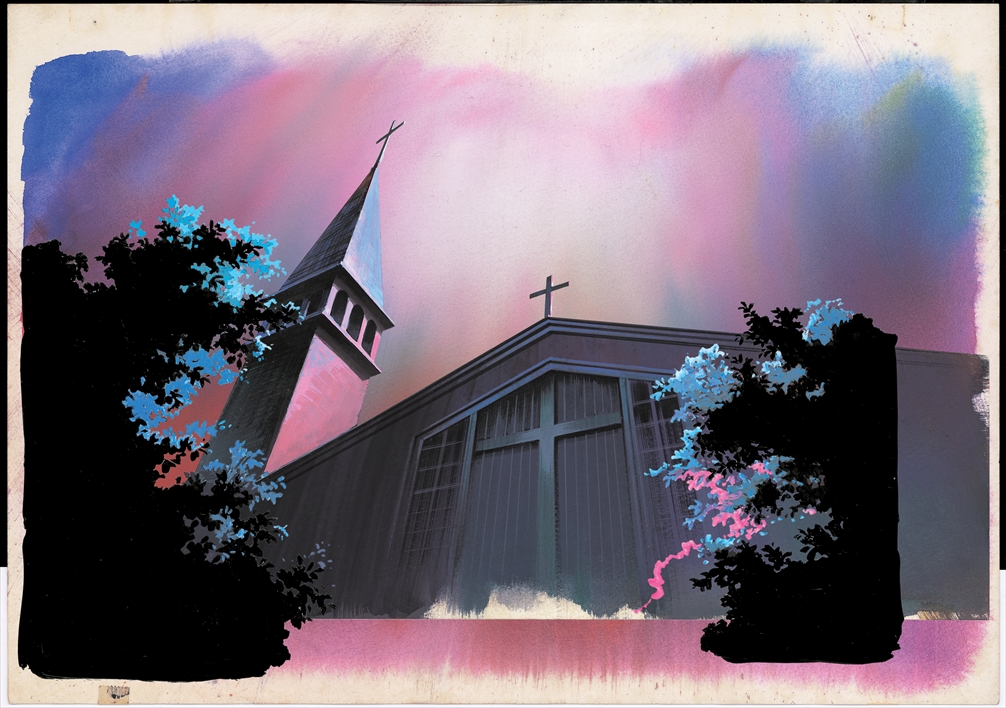

As for Kawajiri’s designs he opts for a super over the top masculine/feminine, and adultish aesthetic with long arching noses on women and men. Women have a very sleek look meanwhile the men are very traditionally more rigid almost looking a ken doll, yet more muscular. This look is also achieved with thick shading and very detailed interior linework on reflections of hair. Although that is great and all these designs are a pain to animate in motion, especially for a director who regularly insists on slow motion or fast motion scenes on 1s. Thankfully there was great key animators with future Madhouse director Tensai Okamura, Nobuyuki Kitajima, and a god within the eye of boomer animators Takuo Noda. This was the earliest credited roles of Takeshi Koike, and Hiroyuki Horiuchi both whom were doing in betokening at this time. With heavy corrections, and diligent planning Kawajiri was persistent in his direction and held back no half asses attempts here as seen in his storyboards.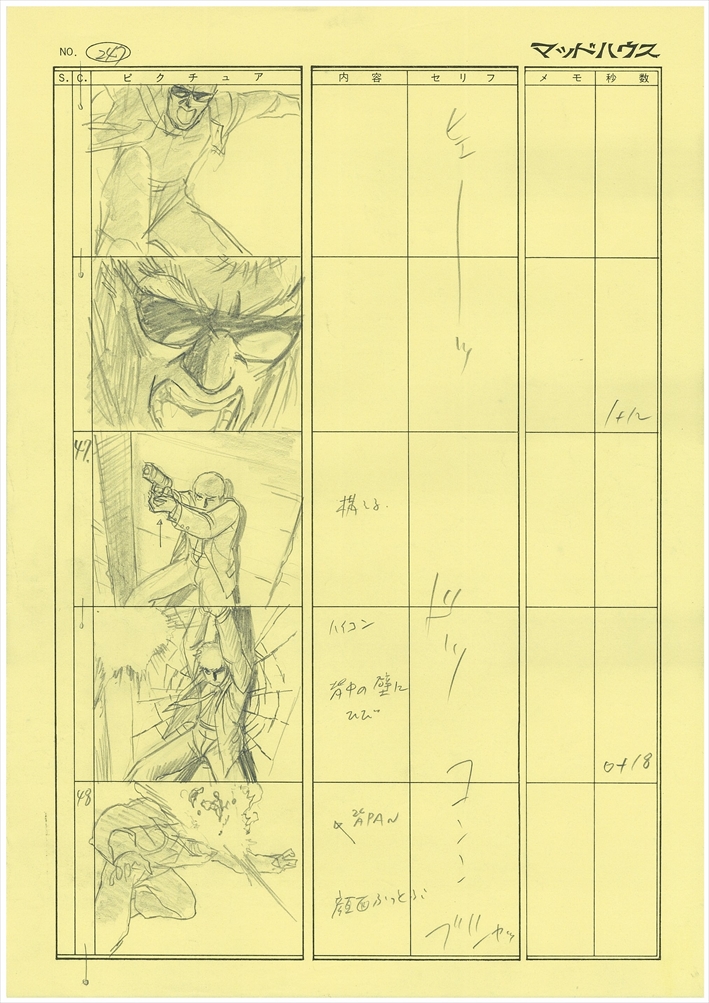
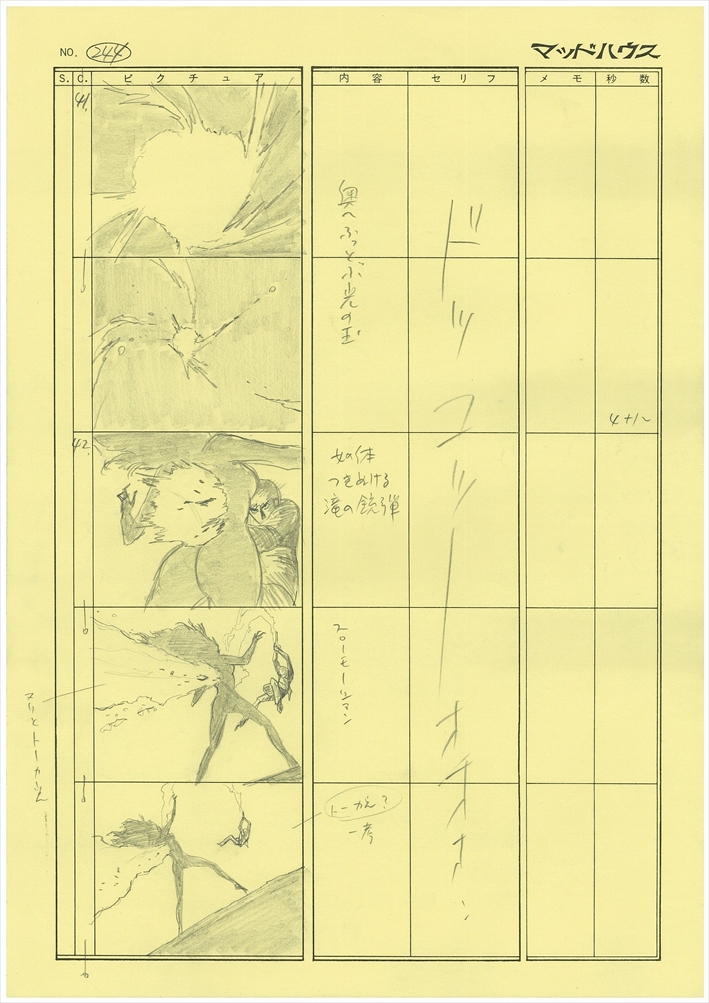
Even with a film as risqué, sexually exploitative, and even somewhat misogynistic? Kawajiri puts on a wild ride here, and fun fact this wasn’t even his first directorial effort as a creative as that came several months before hand on a project released after Wicked CityNeo Tokyo or originally named Labyrinth Tales was a three person anthology film with Rintaro, Katsuhiro Otomo, and Kawajiri all directing their respective shorts.

This short was a big turning point in anime, cementing a lot of experimental qualities that informed different schools of animation forever, even predating Otomo’s Akira a year after, and Robot Carnival too coming out being another jump point.. Kawajiri was placed on The Running Man animated segment where the insane pool of talent brought together a dark, and dystopian cyberpunk hellscape in a world where racing is the only way to live. The short is very visceral with such a soothing score and oppressive sense of atmosphere. The neon tinted colors are all reinforced here like on Wicked City yet way more dirty, and more noir-esque in some aspects. Everything from the mechanical designs of the cars, to the character to designs, and background has an extremely tempered and meticulous attention to detail in it, even the compositing team does very advance layering to get many of the colors to pop in a frightening way.



Only some of the top draftsmen in the industry were given participation here, Nobumasa Shinkawa was a longtime Mushi Pro adjacent fitted for some scenes here, with the addition of two freelance TMS and Ghibli adjacent animators with Toshio Kawaguchi and Shinji Otsuka being here. Although with a small team of animators, Kawajiri seemed insistent on adding himself in here, as the top credited animator. The shattering viscera of the psychic power scene is where he placed, himself with the head driver Zack Hugh pushing himself to the brink. The pure shell-shocked imagery Kawajiri is able to place in this sequence is so insane, his seniority over super-masculine hyper violence is outshined by any other director, even in his own KA here he is able to put on a famous show-stopper of cuts that will be ingrained in your conscious permanently.After doing several commissioned works, we move on to Kawajiri’s second full length animated feature film on Demon City Shinjuku


While arguably not as iconic as Wicked City, it is yet another iconic feature of Kawajiri’s late 80s output featuring stunning blue, and red tinted backdrops with yet again gore heavy scenes used to shock. Kawajiri is once again on character designs, along with a lot of the same members from the Wicked City team. Comparatievely from Wicked City, the designs on Demon City were a bit more simpler, with more bishoujo and bishonen characteristics in the two leads as opposed to the gruff X-rated vibes from the previous movie. This is made very clear in the female mc Rama
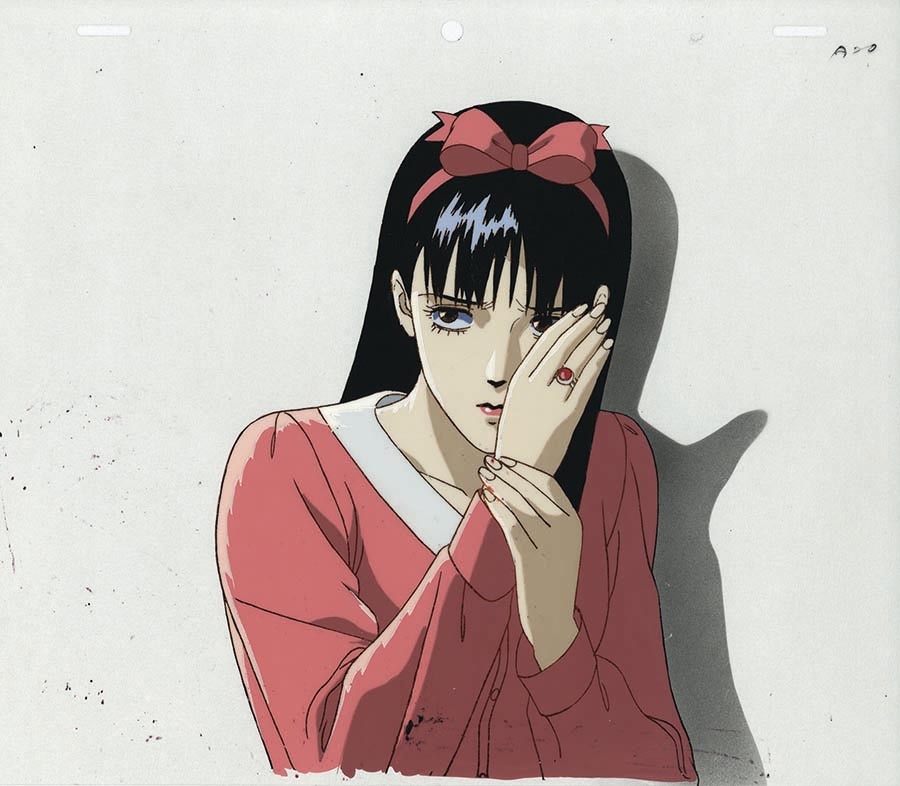
What Shinjuku lacks for in story the animation quality seriously is able to pick up in some scenes. The staff is able to vibe more with Kawajiri’s aesthetics resulting in scenes like this. The film is packed to the brim with aesthetically pleasing sequences like this and is able to carry the more quiet parts through background atmosphere. Also very gif oriented
Kawajiri would further perfect his character designs, and modernize his aesthetics on his next project Midnight Eye Goku

Unfortunately this series has not been as well preserved as other Kawajiri Madhouse series from this era (edit a blu ray came out recently), but feel free to watch both specials here

Enjoy this funny English dub
Whats made more apparent in this series is Kawajiri’s subtle change in male character designs. With Kawajiri gravitating towards heavily masculine designs, he started to add very prominent thick noses to some characters, particularly the protagonist. This was not the product of his own model sheets but Hiroshi Hamazaki furthering the visual style of Kawajiri for years down the road.
For the two OVAs themselves, they aren’t exactly the most gripping Kawajiri material, but still make up for it with his wonderful 80s pilled direction. After in-betweening for so long Takeshi Koike was finally able to get a KA debut Much like Kawajiri, Okamura, and Hamazaki, Koike at an early stage seemed to have mastery over the gritty feel in his animation.Cyber City Oedo 808 was Kawajiri’s next project afterwards, released in 1990


The last cry of Kawajiri’ 80s approach, in regards to character designs, appearances, and execution. A 3 episode mini-series comprising of a rough sci-fi story with criminals who fight crime to reduce their sentences. There isn’t much to further Kawajiri’s aesthetics here as everything remained the same until 3 years later.
In 1993, Kawajiri along with support from Maruyama, and heavy influence from Futaro Yamada, he released his first fully original feature film Ninja Scroll

Getting closer and closer to Kawajiri’s opus, the draftsmanship of Madhouse staff had seriously improved and was quick to adapt to an edgier 90s style Kawajiri opted for. Focusing on feudal era Japan with high tier ninja sequences, some of the best animators in the industry were asked onto the film, along with stunning background art and layout artists. Yutaka Minowa was on character design duty and animation direction, with Kawajiri on prioritizing the detail in finalizing everything. Okamura, Noda, Koike, Mihara and Hamasaki all returned with several new members on the KA staff including Yoshinori Kanemori (who hadn’t been with Kawajiri since Barefoot Gen), Hiroki Kanno, Shougo Furuya who had graduated from being an in-betweener, then two distinguished Akira alumni Kouichi Arai and Hirotsugu Kawasaki. The latter being one of the most favored of the staff for their insane and well paced KA. This film also welcomed the introduction of Kumiko Takahashi who’d become essential in shifting the design departments in Madhouse’s 90s era.So in regards to Minowa, his designs perfectly matched Kawajiri’s mature themed storytelling.



Not a lick of detail is missing, even in regards to weapons details, or even the snakes on the Snake Lady’s back


And of course the highly detailed character genga, which I’m sure would make a pain for productions nowadays


As for animation this movie was among the huge inspirations for the Wachowskis on The Matrix six years later, and its largely in part to some of the strongest boarding Kawajiri has ever done in his entire career. Each and every scene here is so meticulously crafted and paced in memorable action scenes that you could pretty much ignore what is narratively a somewhat hollow experience.

The first fight scene with Jubei fighting Tessai is a pinnacle action scene within the story and one of the first encounters of the villains. Much of Kawajiri’s boarding remains the same but in regards to the animation their is a higher degree of anticipation within the motions of the characters, and more attention to how they move. Takeshi Koike handles a majority of the fight after Jubei is able to break Tessai’s rocky body, and the fast paced smear work is imbued with a lot of weight and detail.
In the middle of the film their is also just a slide show of insanely impressive fight scenes. The bridge battle handled by Kawasaki feels like a more lively Kawajiri board, with the realism school sakuga applied to it, with fantastic anticipation. A sensual fight with the snake lady, and even Kawajiri himself did a scene with Jubei killing Mushizo.
The highlight of the film is likely the last battle with Gemma, the leader of the Eight Devils of Kimon.

A masterfully brutal fight scene, with some of the best portions animated by Kawasaki, who does a total 1 minute and 27 second unbroken sequence which is pretty insane to watch in full. There is a nominal amount of dynamic excellence made for not just the build up and suspense of the fight, but also good allocation of cuts, and less hold time on flashing white backgrounds.
So, for the next 7 years or so Kawajiri was mostly in supporting roles, he did minor works doing storyboards and script work on movies like The Cockpit, and Bio Hunter also doing designs on shows like Azuki Chan which were more Shin-Ei inspired character designs, and did KA and supervision on the Memories segment Stink Bomb which was Tensai Okamura’s debut as a director. Kawajiri also supported Rintaro on X, and also Takahashi on Cardcaptor Sakura with him on storyboards
During this time, the only OVA he directed was Birdy The Mighty


Adapted from Masami Yuki’s mangas of the same name, many of the Kawajiri-isms are sadly lost in this film. However, due to new staff, and updated methods for character acting, this four episode OVA feels very loyal to the source material. Fumiko Takahashi was on designs also sparing no time to make everything as accurate as possible to the manga. A lot of the show translates the fun expressivity from the manga perfectly with really fun scenes. Thanks to that freedom, there is more character acting than in any of Kawajiri’s previous works leading to high spirited, and upbeat action set pieces where our protagonist is more than happy to beat up on the henchman and villains.

Lots of new great animators supporting the episodes like Nobutoshi Ogura from Gainax, and Norimitsu Suzuki (a soon to be member of Bones)
After years of planning, and supporting Takeshi Koike through what would soon be his creative period, Kawajiri released a 2000 adaptation of the third novel of Vampire Hunter D titled Demon Deathchase by Hideyuki Kikuchi, cutting into a full length movie called Vampire Hunter D: Bloodlust


Without a doubt Kawajiri’s crown jewel of animation. Through a darkened fantasy lens, chiefly matching magical spiritual phenomena to real world gore, mixing the two with a sprinkle of atmosphere. This film unlike his previous work feels less focused on the raw edge of every scene and more on the perfectly and highly detailed character designs and background drawings. I have scene few handrawn movies outside of Ghibli, able to achieve such a consistent and high tier level of animation direction for what are super difficult character designs, with a lot of highlights, shading, and line work. Once again Yutaka Minowa is on AD direction and designs, and Hiroshi Hamasaki, along with Hisashi Abe on AD who had been another long time animator at the studio. For background design Ikehata fell into the role delivering his best work.
Minowa’s designs are familiar for Yoshitaka Amano’s originals, but match the updated and detailed sleek male look that had dominated the late 90s after works like X, some of Yasuomi Umetsu’s and Hiroyuki Okiura’s work sprinkled in there too but even more over-present in detail





This even goes into the vehicle designs, which have an insane level of craftsmanship by Murifumi Naka


And the key frames are of Michelangelo quality for anime
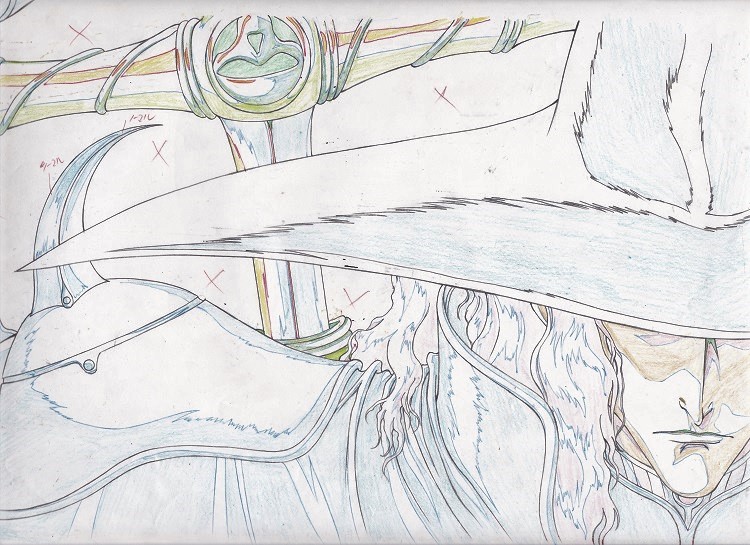
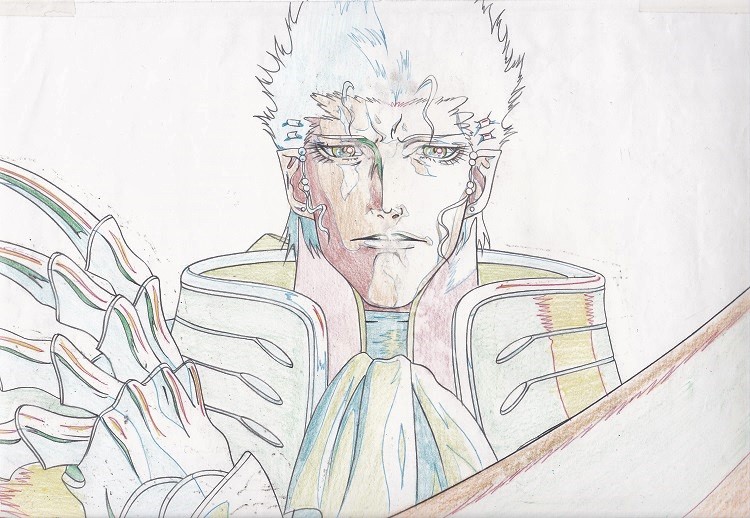
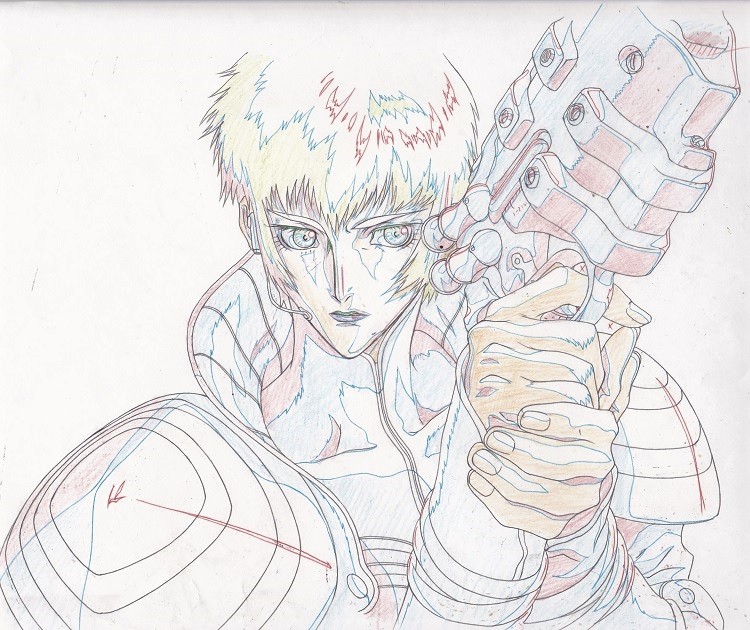
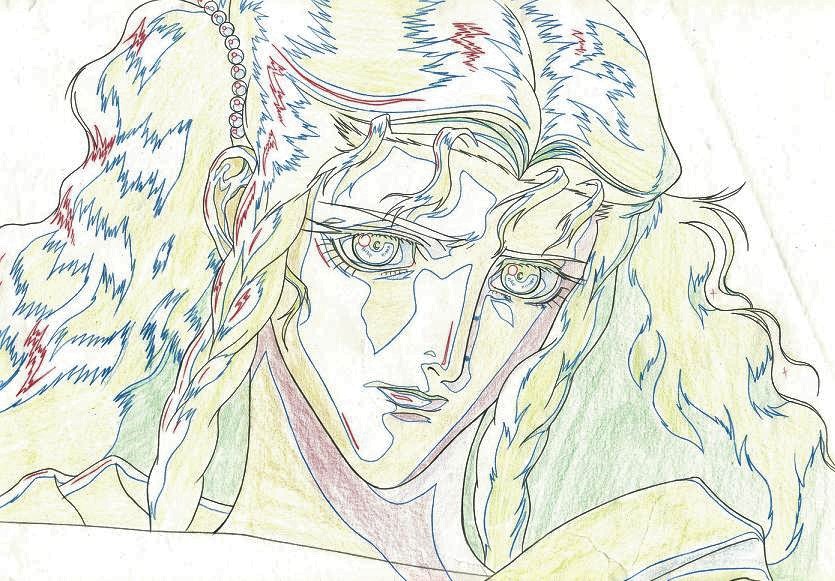
The true MVP here is Yuji Ikehata, who I mentioned that is art here is his strongest, and it is of the highest most esteemed examples of background art rivaling that of the Kazuo Ogaa, who by this point had moved to Ghibli, but was able to support with some paintings.
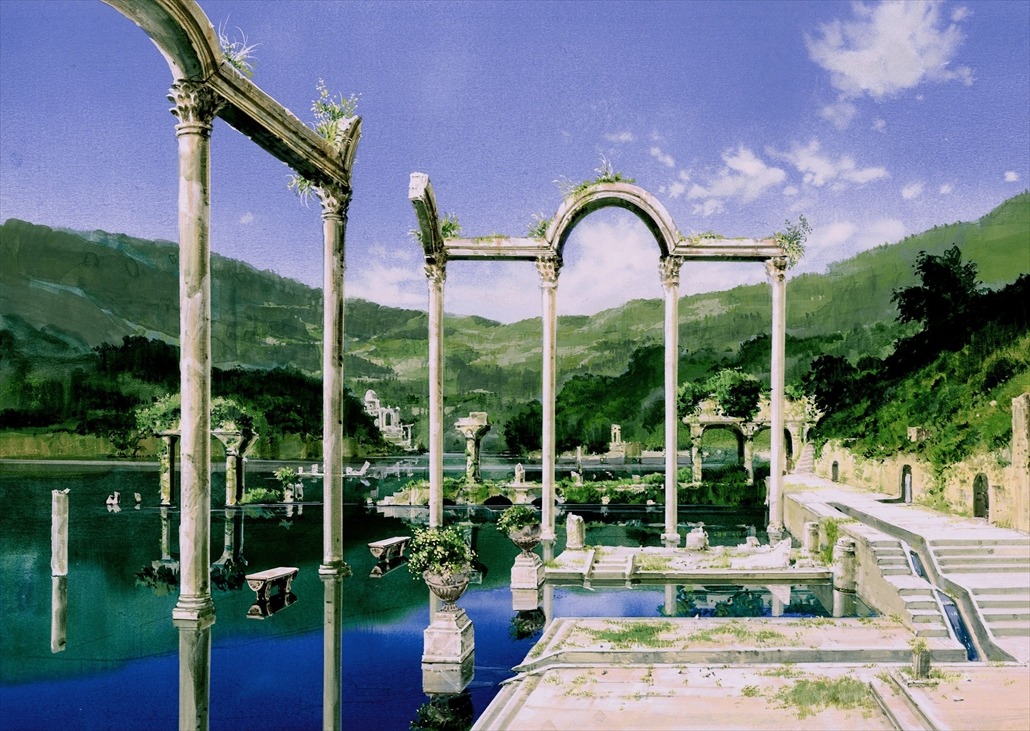
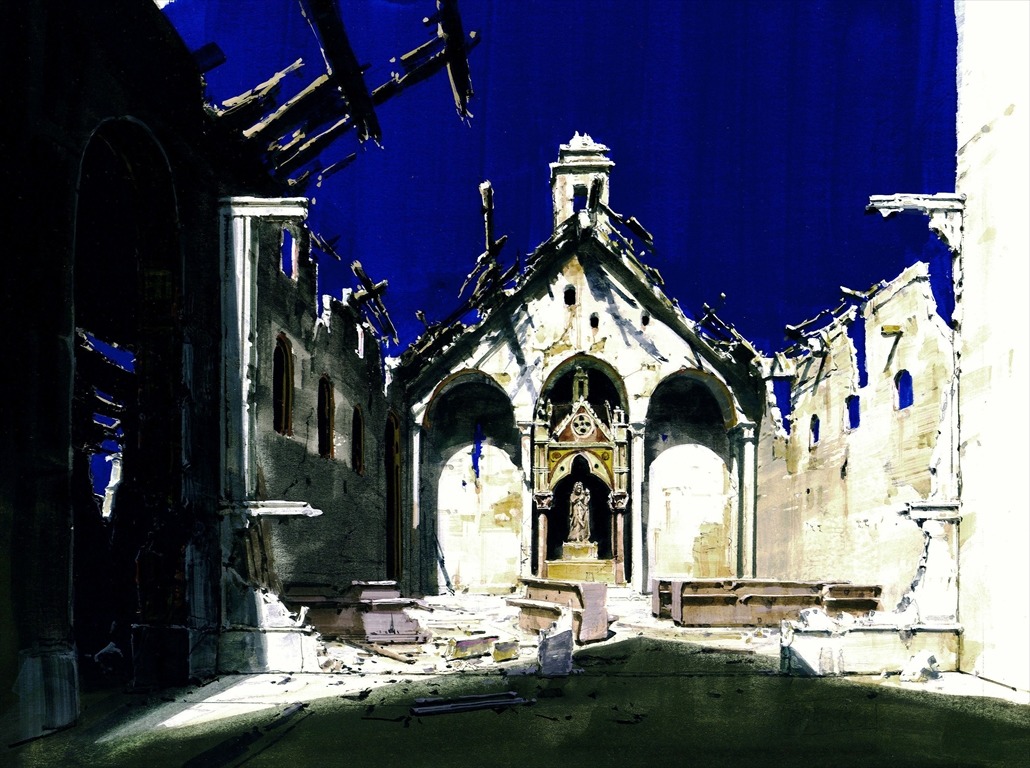
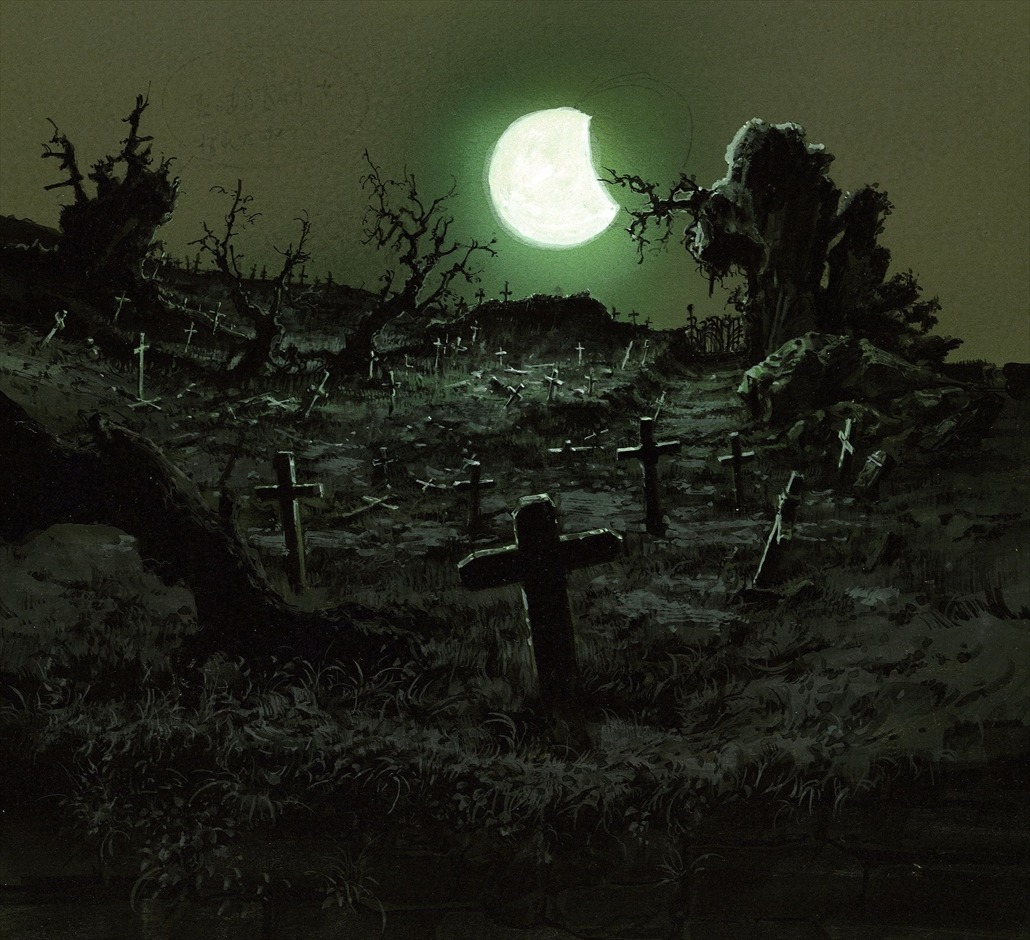
It is an enticing ensemble effort made possible by the best in the industry. It is crazy to think that the film had a total of only 24 key animators including Takeshi Koike, Hideki Futamura, Shigeru Fujita, Takahiro Tanaka, Production IG wolf Kazuchika Kise, Yasushi Muraki (coming back from Stink Bomb), Shinya Takahashi (coming back Bio-Hunter), and legends like Nobumasa Shinkawa who had been with Kawajiri since Madhouse’s inception. There is not a single animator to really highlight here since every single person here was likely corrected or retaken by Minowa and Kawajiri, so much of the individuality in the animation is gone with everyone going a trillion miles to make it look consistent. This sand manta ray scene is pretty kino tho.
Also look the full movie!

The same year Kawajiri helped support his protege Takeshi Koike oh his directorial debut to the opening of Party 7 doing KA assistance along with Koike himself and his influence for his designs goin forward Aeon Flux director Peter Chung

Kawajiri 3:01-3:25
The next year Kawajiri took upon another directing job on X the animated series, after finishing KA on Rintaro’s Metropolis.


Coming 5 years after Rintaro’s 1996 film adapting the well renowned Clamp series, which Madhouse was eager to cover much of their material around this time. There were a few overhauls in character portrayals with this series. X is the story of a psychic esper named Kamui, who’s powers are meant to shape humanity’s fate, with two partying organizations wanting to take advantage of his talents. Kawajiri had considered the character pretty weak due to his emotionless nature instead depicting him as stoic, then easing viewers into his drawbacks as the narrative progressed. This was also made in regards to supporting characters like Fuma and Kotori who both went through changes to better fit what Kawajiri wanted yet still trying to maintain a sleuth of the manga’s charm. On production, Yoshinori Kanemori was on character duties, as well as being Chief Animation Director. The show doesn’t have a lot of animation, but much like Kawajiri using atmosphere he had to rely on that and dialogue more than ever before, being a full length two cour show.
Kawajiri along with Koike and Chung, were among the list of creators by the Wachowskis asked on to The Animatrix

A stunning anthology series showcasing the experimental nature of animation through the escapist virtual world, it is one of the best anthology films ever made. Kawajiri and Koike were asked on to do two short stories for the movie, and landed on Program and World RecordThe first of these two were Program which was Kawajiri’s short

This short revolves around Sis who battle a counterpart named Duo in a training simulation in feudal Japan, that through head sockets former humans of the Matrix were able to invent and build to their liking. Some of the most heavenly, and high powered Kawajiri-isms rest within this short. There is a really stark mutable color design etched into the characters and scenery thanks to creative key color artist Osamu Mikasas, and of course Yutaka Minowa returning his insanely detailed character designs


There are some pretty displays of fight sakuga here with perfectly timed in-betweens, and AD work on display, almost if not just as good as Bloodlust’s. All of the hallmarks of slow motion, slice ins, and rapid zooms are here which is ironic to say since Kawajiri invented a lot of this stuff with the Wachowskis aping off his style.The second was Koike’s directed World Record, where Kawajiri wrote the script

Much like the name suggests, a world record is where a person pushes themselves to the limit, breaking themselves in the process to do the impossible. Koike is able to achieve that very well through the storyboards, but also his character and color designs
Inspired by Chung and elements of American comic book writer Mike Mignola, Koike finally had grown into Kawajiri’s strongest pupil, and not only a great animator but a director. The boarding is so sensory, and the people move in such a stretchy and deformed way that it is almost jarring. However, Koike doesn’t go anywhere close to Shinya Ohira territory, everything is on model and precise, with mostly Koike himself animating the short. It is a perplexingly good visual display and cemented him as a next runner up for a feature film or series.
Kawajiri’s next big effort three later, would unfortunately sully his career for a long time. Highlander: The Search for Vengeance

Based on the spurious franchise, with a cult following Highlander. First released in 1986 as a solo live action film, with a number of sequels and series coming with their pros and cons, Kawajiri was talked on to direct an animated movie, with a bit “touch and go” esque control over the project. David Abramowitz was on writing duty, and in partnership with Imagi Animation Studios the movie went through the production pipeline around the mid 2000s. It was a strange decision how this was greenlit, but was ultimately Maruyama’s decision to make. Where the film ultimately lacked, was a bad weak story from the start, and not a ton of strong and fun animation that could possibly live up to the more lively and fun vibe that the original film could. Along with the fun 80s cheese. There is elements of Bloodlust with the lowly wanderer element, but not a ton of character in regards to a constantly shifting setting, and timeline. It became a mess, and despite some hints of greatness in the animation, everything around it was pretty bad. Plus some shotty CGI here and there. Towards the latter half of production Kawajiri, didn’t even get final cut on the film as at least 10 minutes were cut, left on the cutting room floor for months until a DVD “director’s cut” was released.After directing a Batman short Kawajiri assisted with Takeshi Koike’s 7 year in the making directorial debut Redline

A stunning race film, existing within the world of Trava it was only right for Kawajiri, and Maruyama to get behind such a huge project. A ton of animators were needed for the film, and pretty much marked the last big outcry of Madhouse original directorial talent. Lots of old senior staff assisted with film, including Kawajiri who did pretty much a 1 minute and 33 scene of character acting with the Commander. Not his most riveting work, but deserving of attention due to being able to still pull off unconventional scenes like this.The next few years afterwards is where Studio Madhouse had basically fallen apart. Throughout the decade a lot of creatives had come into Madhouse’s doors to call their home, but an unfortunate amount of circumstances over just two years had it all crumbling down. In 2010 Satoshi Kon passed away, and as rampant financial difficulties began to hit the studio due to Maruyama putting out films and shows for his own creatives rather than to turn a profit things started to turn dour. This was even more apparent with the acquisition of Madhouse shares by Nippon TV in 2011, and a few months later after that had happened Osamu Dezaki, one of the key founders had also died. There was a huge culture shift now with more creative interest held by Nippon, and with that and the lost of their best friend Dezaki, Masao Maruyama went on to found Mappa that same year. This lead to an exodus of directors, writers animators, producers, and color artists to go over with Maruyama to Mappa or just other studios entirely. Rintaro himself hadn’t been involved in many projects for years, so the only founder left was Yoshiaki Kawajiri
Kawajiri ever since 2011 has primarily served as a storyboard artist, having a dwindling say so or leadership role in the company, and just comfortably filling some role to fill. There was a glimmer of hope in 2014 which what seemed like a Ninja Scroll sequel, with a trailer here

But with a lack of funding in away from investors, and probably lost of interest in the material it is sad to see that we will likely not get to see Kawajiri live out his final works, as he is now the lone founder of what was a top tier studio.
But things aren’t all bad. There has been a slew of series he has worked on as an SB such a Chihayafuru, One-Punch Man, Sonny Boy, and Boogiepop Wa Wawaranai all directed by interesting talent Shingo Natsume, and even on the series he hasn’t worked on Madhouse has still been able to keep up a somewhat relevant status in the industry this day maintaining a kind of stationary role for creatives to come in and try things out no matter how successful they are, albeit not without the backing behind the esteemed Maruyama.
So that is Yoshiaki Kawajiri. He is one of the founding members of Madhouse, and what a legend he is. He is the influence behind The Matrix, the mentor to Takeshi Koike, who was and still is one of the most badass anime creators in the industry. Being able to outlast for so long given his darker repetoire, its amazing how much Masao Muruyama stood behind every single one of his projects even if turning a profit wasn't the goal. Kawajiri had some of the best animators and color designers in the world working on his projects, and only through his touch could he make such vivid and gruesome animations. Admittedly writing wise, Kawajiri isn't the strongest with a lot of his stoicism falling into cliches, but when he was on he was on. Vampire Hunter D: Bloodlust is visually one of the most stunning looking animated films ever made, and even with its breezy run time it only feels like a snapshot of his catalogue, which has all the edgy hallmarks anyone could ever want. He is a venerable artist and auteur animator, specializing in long gone lone hero anime traditions. I hope he is able to get around funding for another project, one last time, is all he needs, and probably all he wants now.
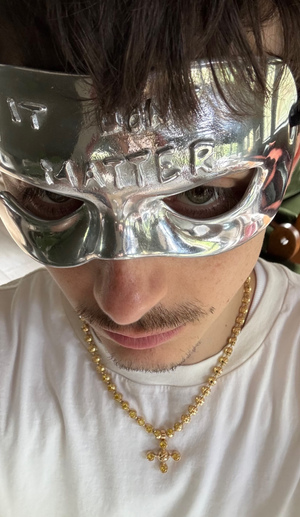 FREE 💜Nov 30, 2023
FREE 💜Nov 30, 2023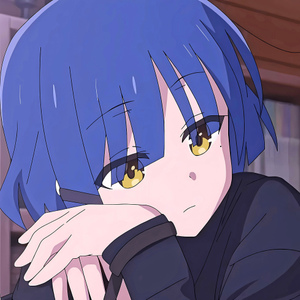 Carmen is Composed
Carmen is ComposedAfter assistance on Rintaro’s Dagger of Kamui and Barefoot Gen director Mori Masaki’s Time Stranger (in which Kawajiri does yet again metallic looking disintegration effects) after 12 years at Madhouse, Kawajiri made his full fledged directorial debut on Wicked City
!https://youtu.be/3wOqciTZRik
A bonafide foundation layer for his future style, and the genesis of the blue and red streamed neon city backdrop of 80s animation. An adaptation of all things, Wicked City adapts the “Black Guard” chapter of Hideyuki Kikuchi’s novel series of the same name (Kawajiri and Kikuchi worked very closely with each other here). The plot revolves loosely around the idea that humans and demon world’s intersect and an order known ad the Black Guard remain mediators between the two civilizations. Its a very experimental effort from a relatively young studio, and is all in part due to Kawajiri’s nightmarish direction, with stark color settings by Michiyo Iriomote, and background designs by the legendary Yuji Ikehata who would become a staple in the Madhouse art department.
Despite admittedly not a great story. Wicked City makes up for it with its sensational character designs, a stunning color setting, and gore heavy sci-fi. As one Anilist review said it best “enjoyable schlock if you will”.





Out the door are the characters, instead draw your eyes to the visuals which Kawajiri makes a feast for, and the film is prime example of being the subject of dozen of “80s anime style rules” or looping “80s gifs” for “aesthetics” and slowed versions of songs
yet most people have not even observed the movie on its own merits. Yes its okay, but the style seriously carries. I mean look at Kazuo Oga’s art

As for Kawajiri’s designs he opts for a super over the top masculine/feminine, and adultish aesthetic with long arching noses on women and men. Women have a very sleek look meanwhile the men are very traditionally more rigid almost looking a ken doll, yet more muscular. This look is also achieved with thick shading and very detailed interior linework on reflections of hair. Although that is great and all these designs are a pain to animate in motion, especially for a director who regularly insists on slow motion or fast motion scenes on 1s. Thankfully there was great key animators with future Madhouse director Tensai Okamura, Nobuyuki Kitajima, and a god within the eye of boomer animators Takuo Noda. This was the earliest credited roles of Takeshi Koike, and Hiroyuki Horiuchi both whom were doing in betokening at this time. With heavy corrections, and diligent planning Kawajiri was persistent in his direction and held back no half asses attempts here as seen in his storyboards.

Even with a film as risqué, sexually exploitative, and even somewhat misogynistic? Kawajiri puts on a wild ride here, and fun fact this wasn’t even his first directorial effort as a creative as that came several months before hand on a project released after Wicked CityClassic































